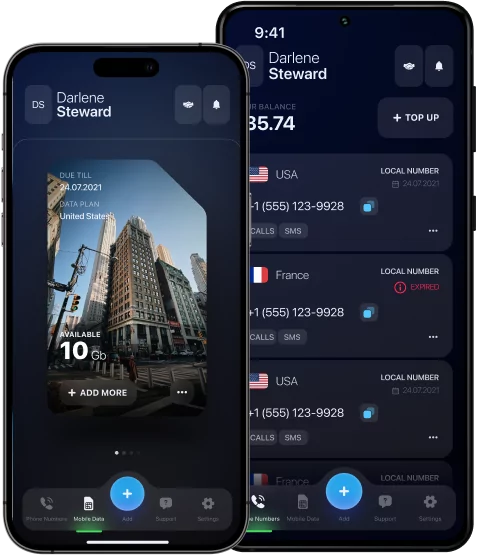Does a SIM Card Store Data?

A SIM card is a microscopic chip that makes it possible to communicate on a mobile network. But in fact, the “SIM card” can do much more. Does a SIM card store data of users? Let’s consider the topic below.
What is a SIM Card?
A SIM card is a contact smart card with its own processor capable of registering on a mobile network. It is able to find the nearest transmitting station and store information: numbers, SMS and other data.
The SIM card has a permanent (non-volatile) and RAM. There is also a hardware encryption module and a hardware random number generator.
The SIM card processor operates at a frequency of up to 10 MHz. Permanent memory is divided into areas: about 60% is occupied by operator data, 20% is the operating system, and the rest is user data.
Do SIM cards store data? Sure! Read more below.
What Data Does a SIM Card Store?
First of all, the SIM card stores KI and IMSI numbers, as well as other information.
IMSI (International Mobile Subscriber Identity) is the international mobile subscriber number. It is forwarded to the network but only during authentication. When possible, instead of IMSI, the smartphone sends a TMSI-generated temporary ID based on IMSI.
KI (Key Identification) is a unique 128-bit user authentication key. You also need it to log in to the network. KI is generated using the A8 algorithm, authentication takes place using the A3 algorithm.
SIM cards store the information necessary for a successful connection to the cellular network: identification number, and technical data of the phone. Information supporting security: PIN and PUK codes. Network settings: internet settings, SMS service center number. There is also a certain amount of free space for storing phone service information: contacts, SMS, and numbers.
Subscriber Information
KI is the most important part of the card from a security point of view. It is this key that encrypts all data that is transferred from the card and back, so the key is stored in an area of memory that is not readable. Even if you connect the contacts of the SIM card to another processor and try to get all the data directly, it will not work.
PIN and PUK information is also stored here.
Network Information
ICCID (International Circuit Card Identity): A unique 19-20 digit serial number assigned to each SIM card. You can find it on the map itself or in the phone settings.
IMSI is responsible for registering the card on the network — using it, the telecom operator understands which SIM card it is. Next, the operator looks into the database and determines which number is linked to it.
Contact Information
The SIM card can store a limited number of contacts (usually up to 250), including name and phone number.
SMS Messages
Some SIM cards have limited storage for SMS messages but in modern smartphones, messages are usually stored in the phone’s memory.
Other Data
Each SIM card contains a serial number and the number of the mobile phone linked to it. It also stores temporary information about the network in which the subscriber is located. Simply put data on which particular cell tower it is connected to at the moment or was connected to in the previous period.
The SIM cards also contain data from applications installed on the smartphone. In modern smartphones, such data is stored in the memory of “SIM cards” only by operator applications.

How Do SIM Cards Store Data?
SIM cards store a lot of data, including those related to the subscriber, his identification, and presence on the network.
How does a SIM card store data? The SIM card has a full-fledged multi-level hierarchical file system. Access to different levels is protected by different codes. Subscribers are provided with PIN and PUK codes that protect the upper layers of the file structure. They are necessary to gain access to the money in the personal account and information related to the SIM card.
The lower layers with identification data are protected more reliably. The KI key, which is used to identify the user on the network, is stored exclusively in the SIM card processor. It is not transmitted “outside” and is stored in a read-protected memory area.
Operators do not release special API toolkits for accessing the KI key. The key cannot be read, changed, or copied. Or is there a way?
Security and Privacy Concerns
Almost all accounts of social networks, messengers, e-mail, and banking applications are linked to users’ phone numbers. If the SIM card falls into the hands of intruders, they will be able to access all the victim’s accounts simply by changing their passwords.
Therefore, the threat of SIM theft becomes an urgent problem, even taking into account the two-factor protection of most accounts.
Risks of SIM Card Data Theft
SIM cards have built-in security features that protect the datum stored on them. However, like any other technology, they are not completely invulnerable.
Here are a few ways that attackers can try to gain access to the data on the SIM card:
- Physical access. If an attacker gains physical access to your SIM card, he may try to read data from it using special equipment.
- SIM cloning. This is a complex process in which attackers create a duplicate of your SIM card to intercept calls and messages.
- Network vulnerabilities. Although this rarely happens, hackers can exploit vulnerabilities in the mobile network to intercept data transmitted between your phone and the network.
How to Protect Your SIM Card Data
By and large, SIM cards are protected only by PIN and PUK codes. Cybersecurity experts recommend keeping PIN protection active all the time and, of course, changing the traditional four zeros in the code to something more complex.
Otherwise, the security of using SIM cards is provided by developers of mobile applications – banking, etc.
For example, if you replace your SIM card, the banking application will see that your phone number is the same, but the IMSI number has changed, and will block receiving codes to confirm transactions. To restore access, you will have to contact customer support and confirm your identity.
Read some possible ways of data protecting:
- Use a secure PIN. Choose a PIN that is difficult to guess, and do not use obvious combinations such as “1234” or “0000”.
- Be careful with suspicious SMS messages and calls. Do not open links and do not reply to messages from unknown numbers.
- Update and re-install your phone’s software regularly. Software updates often contain security fixes that protect your phone from known vulnerabilities.
Future of SIM Card Technology
Technology reviews are released annually, which predict the imminent decline of traditional SIM cards. The advent of eSIM is moving the technological setting world but it’s too early to say that we will lose the market for classic SIM cards.
The SMART card technology stays with users, and the SIM card only changes in size from year to year. Many manufacturers are likely to really move towards the development of eSIM for traveling but traditional SIM cards are unlikely to become history.





